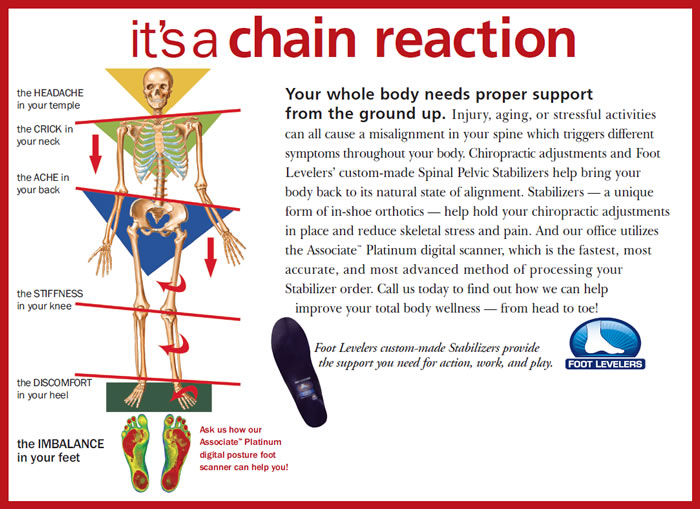Dr. Mark Charrette
It’s no secret that low back pain is a prevalent problem, with 60-80% of the U.S. population suffering. Low back pain is the number second most common reason patients visit a medical doctor; it is the first reason they visit a Chiropractor.1 One study of chronic spinal pain stated that the “lifetime prevalence of spinal pain has been reported as 54 to 80 percent, with as many as 60 percent of patients continuing to have chronic pain five years or longer after the initial episode.”2 The lumbar spine and pelvis balance on the lower extremities during standing, walking, and running. If leg or foot asymmetries or misalignments exist, abnormal forces transmitted along the closed kinetic/kinematic chain can interfere with spinal function. 3
Most chronic low back pain is the result of some form of structural weakness or failure.34 The cause of chronic lumbar spine breakdown is microtrauma, which is produced by the conditions found in Table 1. The source of these conditions must be recognized and treated in order to prevent further breakdown and chronicity. And that source is often an imbalance/condition in one or both of the feet.
The feet are the foundation of the body. Statistical evidence shows that at birth, most of us have perfect feet. By age 20, 80% of those “perfect feet” have developed some type of problem, and by age 40, nearly everyone has a foot condition of some sort. Many foot conditions eventually contribute to health concerns farther up the kinetic chain, especially the generalized condition of “back pain.” Therefore, it’s in the best interest of both you and your patient to be able to spot a potential low back problem before it is allowed to affect a patient’s health and/or lifestyle.
Orthotic Supports
A significant factor in reducing excessive biomechanical forces on the lumbar spine is frequently overlooked by practitioners: the use of external supports (orthotics, heel lifts) to decrease external forces. The following are commonly seen conditions in which the lower extremity can have a major impact on lumbar spine function. In each of these situations, orthotic supports are not only appropriate, they will contribute significantly to a cost-effective treatment outcome:
- When excessive pronation and/or arch collapse of the foot is present, a torque force produces internal rotation stresses to the leg, hip, pelvis and low back.5 The result is recurring subluxations and eventual ligament instability affecting the sacroiliac and lumbar spine joints. These forces can be decreased significantly with the use of flexible, custom-made orthotics.
- In patients with degenerative changes in the lumbar discs and facets, the external force of heel strike may aggravate and perpetuate low back pain, and is easily reduced with the use of shock-absorbing shoe inserts6 or orthotics which contain viscoelastic compounds. The reduction in symptoms is often dramatic.
- An anatomical difference in leg length produces abnormal structural strains on the pelvis and low back. These strains can cause not only chronic pain,7,8 but also have been shown to result in specific degenerative changes.9 The use of lifts and orthotics has been shown to reduce these structural strains and bring about significant response.10 Yochum demonstrated how a 15.5 mm LLI in a patient could be reduced to just 4 mm with the use of flexible orthotics (Fig. 1).11 Not only had the pelvic deficiency been markedly reduced, but the right compensatory listing of the lower lumbar spine had also diminished.

Helpful Hints
Asking your patients a few simple questions (below) can provide valuable insight into the cause(s) of their back pains. When the back acts up, look to the feet!
- Do you stand or walk on hard surfaces for more than 4 hours daily?
- Do you participate regularly in any physical sport (basketball, baseball, tennis, golf, bowling, etc.)?
- Are you age 40 or over?
- Have you ever had a prior injury to your knee, back or neck?
- Do your shoes wear unevenly?
- Do you have joint pain while standing, walking or running?
- Is one of your legs shorter than the other?
- Do you have knock-knees or bow legs?
- Do you have any obvious foot problems (bunions, corns, flat feet, etc.)?
- Do you feet “toe out” when you’re walking?
If your patient gives an affirmative answer to any of the above, consider this patient a likely candidate for flexible, custom-made orthotics.
References
- Aota Y, Iizuka H, Ishige Y, et al. Effectiveness of a lumbar support continuous passive motion device in the prevention of low back pain during prolonged sitting.Spine. 2007;32(23):E674-7.
2. Boswell MV, Shah RV, Everett CR, et al. Interventional techniques in the management of chronic spinal pain: evidence-based practice guidelines. Pain Physician, 2005;8(1):1-47.
- Keane GP. Back pain complicated by an associated disability. In: White AH, Anderson R. eds. Conservative Care of Low Back Pain. Baltimore: Williams & Wilkins, 1991:307.
- Fulton M. Lower back pain: new protocols for diagnosis and treatment. Rehab Management 1988; Nov/Dec:39-42.
- Hammer WI. Hyperpronation: causes and effects. Chiro Sports Med 1992; 6:97-101.
- Light LH, et al. Skeletal transients on heel strike in normal walking with different footwear. J Biomechanics 1980; 13:477-480.
- Giles LGF, Taylor JR. Low-back pain associated with leg length inequality. Spine 1981; 6:510-521.
- Friberg O. Clinical symptoms and biomechanics of lumbar spine and hip joint in leg length inequality. Spine 1983; 8:643-651.
- Giles LGF, Taylor JR. Lumbar spine structural changes associated with leg length inequality. Spine 1982; 7:159-162.
- Hoffman KS, Hoffman LL. Effects of adding sacral base leveling to osteopathic manipulative treatment of back pain: a pilot study. JAOA 1994; 94:217-226.
- Yochum TR, Barry MS. The short leg (revised edition). Practical Research Studies 1994; 4(5).
[Table 1]
Causes of Chronic Lumbar Spine Breakdown
biomechanical errors
structural asymmetries
tissue weaknesses
excessive external loads
 Dr. Mark Charrette is a 1980 summa cum laude graduate of Palmer College of Chiropractic in Davenport, Iowa. He is a frequent guest speaker at twelve chiropractic colleges and has taught over fourteen hundred seminars worldwide on extremity adjusting, biomechanics, and spinal adjusting techniques. His lively seminars emphasize a practical, hands-on approach.
Dr. Mark Charrette is a 1980 summa cum laude graduate of Palmer College of Chiropractic in Davenport, Iowa. He is a frequent guest speaker at twelve chiropractic colleges and has taught over fourteen hundred seminars worldwide on extremity adjusting, biomechanics, and spinal adjusting techniques. His lively seminars emphasize a practical, hands-on approach.
Dr. Charrette is a former All-American swimmer, who has authored a book on extremity adjusting and also produced an instructional video series. Having developed successful practices in California, Nevada, and Iowa, Dr. Charrette currently resides in Texas.








